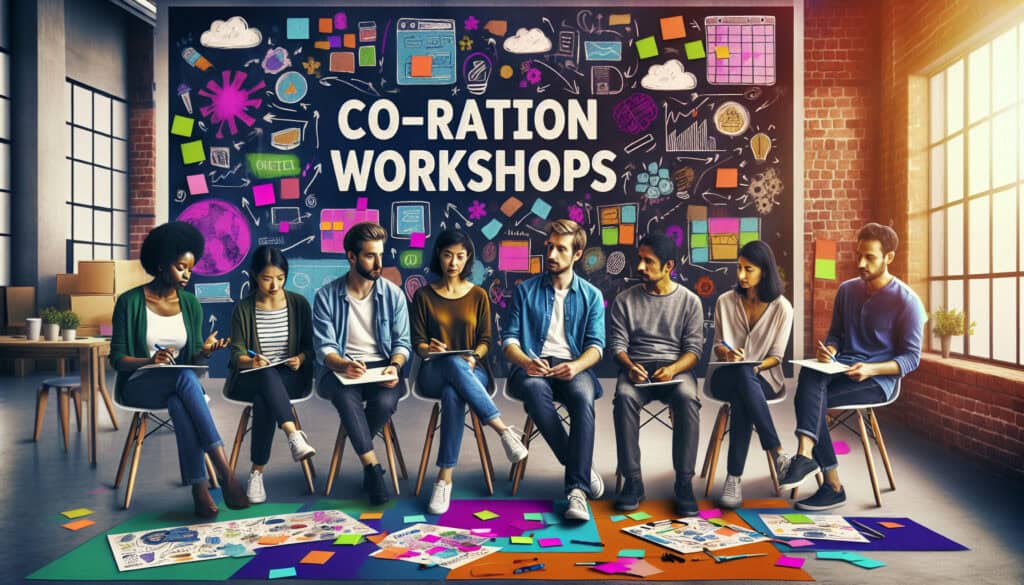Collaborative sessions where a company and its stakeholders (such as customers, partners, or employees) work together to generate ideas, solve problems, or design a product.
- Methodologies: Customers & Marketing, Ideation, Product Design
Co-Creation Workshops

Co-Creation Workshops
- Agile Methodology, Customer Experience, Design Thinking, Human-Centered Design, Innovation, Interactive Design, User-Centered Design
Objective:
How it’s used:
- These are facilitated, interactive events designed to harness the collective creativity of a diverse group of people to produce innovative and user-centric outcomes.
Pros
- Generates more user-centric ideas, builds stronger relationships and loyalty with customers, and can lead to more innovative and successful products.
Cons
- Can be logistically complex and expensive to organize, requires skilled facilitation to be productive, and managing diverse opinions can be challenging.
Categories:
- Customers & Marketing, Ideation, Product Design
Best for:
- Actively involving customers and other stakeholders in the innovation and design process.
Co-Creation Workshops are utilized across various industries such as consumer electronics, automotive, healthcare, and software development, often conducted during the early phases of product design or during iteration cycles. These workshops typically involve diverse participants, including customers, stakeholders, designers, engineers, marketing professionals, and subject matter experts, allowing for a multidimensional approach to problem-solving. The methodology encourages participants to engage in brainstorming activities, sketching, prototyping, and role-playing scenarios, which can yield rich, contextualized insights into user needs and preferences. These workshops not only enhance the creative process but also serve to break down silos between departments, fostering collaboration and communication across different functions of an organization. In the healthcare sector, for example, co-creation can lead to improved medical devices that better cater to patient experiences, while in the tech industry, it can drive the development of software that aligns more closely with user expectations. Such collaborations are initiated typically by product managers or innovation leads who recognize the potential impact of customer involvement in shaping solutions. Further, the approach can lead to stronger brand loyalty, as customers feel more invested in products that reflect their input, engendering a sense of ownership that translates into ongoing support and advocacy for the brand.
Key steps of this methodology
- Define clear objectives for the workshop.
- Facilitate brainstorming sessions using techniques like mind mapping or ideation sprints.
- Encourage open dialogue and interaction among participants.
- Utilize prototyping tools or paper mock-ups for rapid idea visualization.
- Conduct breakout sessions for focused discussion on specific topics or challenges.
- Guide participants in prioritizing ideas through voting or affinity diagrams.
- Document key insights and concepts in real-time for immediate feedback.
- Build consensus on the most promising ideas for further development.
- Engage in creative play to stimulate new perspectives and approaches.
Pro Tips
- Utilize role-playing scenarios during co-creation to uncover tacit knowledge and perspectives that may not surface in traditional discussions.
- Implement rapid prototyping within workshops to allow participants to visualize ideas immediately, speeding up feedback loops and refining concepts effectively.
- Incorporate diverse stakeholder personas to ensure a broader range of needs and preferences is represented, enhancing the richness of the ideation process.
To read and compare several methodologies, we recommend the
> Extensive Methodologies Repository <
together with the 400+ other methodologies.
Your comments on this methodology or additional info are welcome on the comment section below ↓ , so as any engineering-related ideas or links.
Historical Context
1949
1950
1950
1960
1960
1960
1960
1940
1950
1950
1958
1960
1960
1960
1960
(if date is unknown or not relevant, e.g. "fluid mechanics", a rounded estimation of its notable emergence is provided)















Related Posts
METS to Calories Calculator
Meta-Analysis
Message Mapping
Mental Model Diagrams
Maximum Acceptable Pushing and Pulling Forces
Material Requirements Planning (MRP)